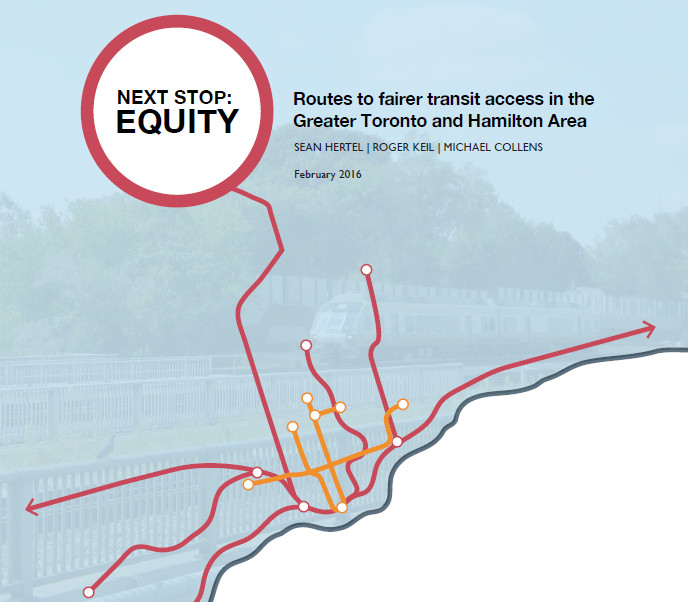By Sean Hertel, Michael Collens and Roger Keil
 In the fast-growing, complex and diverse Greater Toronto and Hamilton Area, transit discussions rarely focus on improving access for the greatest number of people and addressing the complex needs of the public. As plans are made, money is spent, routes are plotted and fare schedules are set, “transit equity” must enter the discussion.
In the fast-growing, complex and diverse Greater Toronto and Hamilton Area, transit discussions rarely focus on improving access for the greatest number of people and addressing the complex needs of the public. As plans are made, money is spent, routes are plotted and fare schedules are set, “transit equity” must enter the discussion.
Next Stop: Equity – Routes to Fairer Transit Access in the Grater Toronto and Hamilton Area, a York University study released today, argues we need to reframe the discussion to consider transit equity, or how to use infrastructure investment and operation to help the greatest number of current and future transit users across the region.
Instead of focusing on equality, where everyone is treated the same, transit equity recognizes that people have different needs, situations and challenges that require different responses.
Research for Next Stop: Equity was funded by Metrolinx and conducted by Roger Keil at the Faculty of Environmental Studies, City Institute researcher Sean Hertel and planning Master’s student Michael Collens. It relied on extensive stakeholder consultations, case study research and an analysis of fares across the 10 GTHA transit agencies. The study makes 18 recommendations for achieving a more equitable regional approach including:
- developing a GTHA-specific definition of equity that recognizes the diverse needs of the region’s residents, to guide future planning;
- creating a consistent regional framework for transit fares, including discounted passes for low-income residents and more broadly defined groups of students;
- implementing land use planning policies to acknowledge and begin to counteract the displacement of residents created by rising property values along new or improved transit lines;
- ensuring new development near transit stations does not result in a net loss of affordable apartments or displace vulnerable residents;
- augmenting service to employment destinations, especially those trips made in off-peak hours, through a further analysis of evolving commuting patterns, especially outside the downtown core;
- enhancing public consultation techniques, especially in lower income and suburban communities; and,
- improving customer service, including vehicle and station comfort and cleanliness.
Widening gaps between affordable housing and employment opportunities have converged to make transit service disparities especially severe in suburban areas. Overall, the historic lack of transit investment means many living in the “inner ring” or “905” suburbs of Toronto must either have access to a car or find a home somewhere else.
Transit, as target for substantial investment by multiple levels of government, has huge potential to balance out social inequalities. It can connect underserved neighbourhoods to employment centres, enhance mobility and utilize subsidies and other fare innovations to encourage ridership. Transit is quite literally a vehicle for providing access to the community, economy and services that make living a fulfilling life possible.
But the discussion needs to depart from the current situation, where politicians fight over limited funding, change plans mid-stream and build new lines that continue to primarily assist commuters traveling to and from downtown at rush hour.
Next Stop: Equity builds upon last year’s report, Switching Tracks. The extensive research, also funded by Metrolinx, included a series of broad-based roundtables, a review of insights and examples from around the world, summary of the region’s patchwork fare system and case studies of neighbourhoods lacking the transit residents need.
The report, with a focus on how the GTHA’s complex fare structures and boundaries contribute to social inequity, and on case studies that paint a picture of how inequity is experienced, is especially timely. Metrolinx is undertaking a review of its $50-billion regional transit plan, The Big Move, and as Prime Minister Justin Trudeau is promising $10 billion in infrastructure investment. Also, the City of Toronto is revising its rail transit lines for Scarborough and introducing new rapid bus lines to create faster connections in the inner suburbs.
While The Big Move already recognizes the benefits of ensuring 80 per cent of residents live near rapid transit, the opportunity is ripe for making transit equity the next stop on the line towards a mobility future where those who don’t have cars or otherwise face obstacles can participate in the full life of the city.
Next Stop: Equity can be downloaded here
AUTHORS & CONTACT INFORMATION:
SEAN HERTEL leads an urban planning consulting practice and is a researcher at the City Institute at York University, specializing in transit-oriented development, housing and suburbs. sean@seanhertel.ca / @Sean_Hertel
ROGER KEIL is York Research Chair in Global Sub/Urban Studies at the Faculty of Environmental Studies at York University and Principal Investigator of the Major Collaborative Research Initiative, Global Suburbanisms: Governance, Land and Infrastructure in the 21st Century. rkeil@yorku.ca / @rkeil
MICHAEL COLLENS is a student in the Masters in Environmental Studies program at York University, concentrating on planning for sustainability and equitability in public transportation. mcollens@yorku.ca / @michaelcollens

